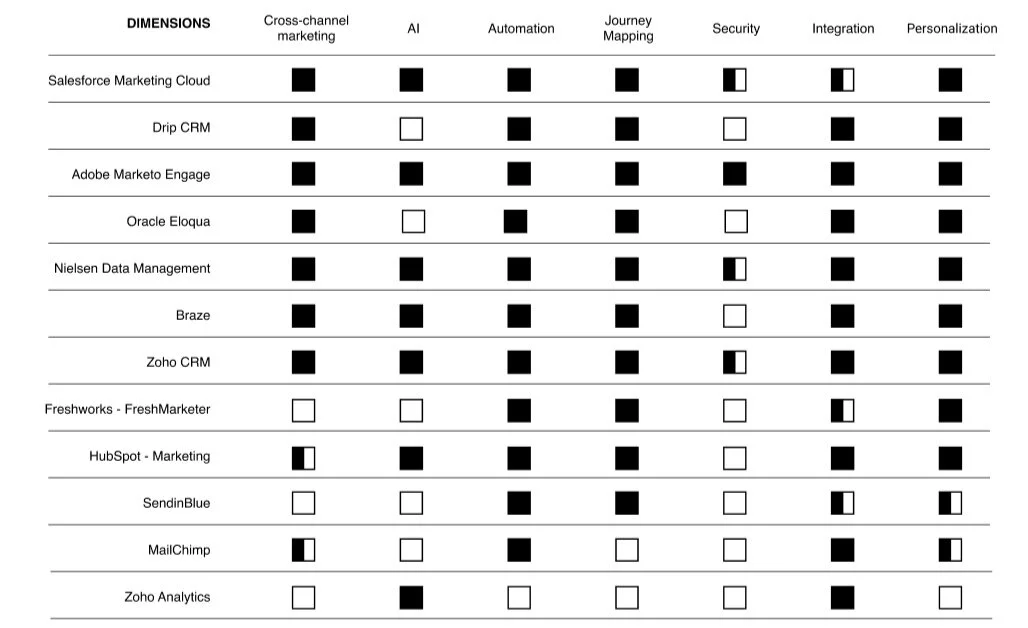Overview:
This project was sponsored by Salesforce Marketing Cloud in partnership with Indiana University’s MS HCI/d program. [This project is in no way related to my work as a Salesforce UX Research extern.]
Duration:
12 Weeks
Tools:
Whimsical, Adobe XD, Figma
Team:
Elisa Krebs, MS HCI/d
Boyu Zhang, MS HCI/d
Weiyi Meng, MS HCI/d
TJ Joshi, PhD Informatics
Contributions:
Collections Workbook, User Interviews, Research Synthesis, UX Design, Prototyping, User Testing, Presentation
Salesforce gave us one task:
increase a marketer’s confidence at the time of send.

The Problem As We Know It
Salesforce supports digital marketers in their day to day role through Marketing Cloud, a suite of 11 integrated tools.
These tools work together to deliver marketing experiences, but Journey Builder allows marketers to personalize the customer journey of acquisition, onboarding, engagement and retention from one platform.
It helps marketers connect with the right customers at the right time and with the right message.
Our Assumptions: Why aren’t marketers confident?
This problem centered around a product we had no experience with and no access to.
Making initial assumptions was the only way to embrace the uncertainty and move forward to finding answers.
Our Process
Due to the nature of the project, we had to get extremely creative about our methods, process and resources.
As a result, our design process was not linear and simple.
This project was challenging, iterative, messy and tested our ability to design for experience, not usability.
This problem is resistant to an obvious solution.
This is because:
The experience needs to be built on confidence, which is developed over time.
The experience of pressing send is dependent on countless other touchpoints.
Marketer confidence doesn’t just come from the tool itself, but many external factors.
The experience can be extremely variable by user, use case or project.

How do you start researching for a product you have no access to?
You pretend that you’re a marketer.
We signed up for free webinars.
We joined email lists.
We watched Youtube tutorials.
We read through Trailheads.
We tried to gather as much context as we could.
Competitive Analysis
With a bit of context, we (unsuccessfully) attempted to conduct a competitive analysis.
We didn’t know enough about our own product to begin to compare it to the competitors.
We didn’t know what key product dimensions were important to marketers.
We didn’t know enough to gain valuable insights.
Collections Workbook
We conducted a collections workbook of 40 exemplars across 8 key dimensions:
Voice and Tone
Customer Relationship Management
Story Building
Flowcharts & Diagrams
Breaking Down a Large Task
Software Suites
Using AI to Improve Experience
Review & Confirmation
The goal was to frame the design space, deconstruct the key dimensions of the experience, and analyze common themes.
Collections Insights
1. Hype ‘em up.
An encouraging tone in a product’s content can relieve stress at points of frustration or anxiety.
2. It’s a diagram of a story.
There are many ways to approach building diagrams and telling stories that think beyond dragging-and-dropping or using shapes.
3. Break it down.
Any complex, long, or scary process can be made easier by breaking it down into smaller, more manageable bits. It makes users feel more in control.
4. Lend a helping hand.
Utilizing a template. Offering suggestions. Safeguarding against errors. We all need it. We mostly love getting it. How can we help marketers more?

User Research
We only found 1 local marketer that was using Journey Builder.
One user’s experience would not be enough, so we recruited 2 additional marketers and 2 data analysts for user interviews.
We focused on the marketing experience overall, rather than the tool, to gain applicable and actionable insights.
“I’ve been dealing with email marketing for 7+ years and I still kind of get butterflies when I hit [send].”
– Digital Marketing Specialist
Key Interview Insights
Our face-to-face time with potential users was invaluable and 3 major themes emerged.

Empathizing with Experience
After talking to our users, we built 2 experience maps to better understand the complexity of executing a marketing campaign and working within Journey builder.
These mappings were based on many assumptions and inferences, but helped us build empathy for our users and align our team’s understanding before moving forward.
Insights from Mapping
Campaign creation is the largest chunk of the experience, but activation is the point of contention.
Can we make the activation less stressful through the experience of creation?Testing a journey before activation seems to slightly improve overall emotion at time of send.
Is there an opportunity to enhance the testing experience even more?The complexity of each journey component isn’t easily accessible in the visual canvas.
How can we balance transparency and visual simplicity?

We relied on theory to make sure we were rooting our solutions in experience rather than usability.
After mapping out the end-to-end experience, we relied on theory to position our thinking.
Hassenzahl’s Model of Experience served as a key theory understanding a marketers’ key goals.
From our analysis and interpretation, the primary position of Journey Builder lies in the Motor Goals of a marketer.
Because Journey Builder offers unprecedented scale, it influences Do Goals, but often frustrates Be Goals.
Are we solving the right problem?
After reviewing the theory, we felt a misalignment between the prompt we were given and the insights we had gathered. Users told us repeatedly that the joy from marketing comes in pre-deployment and post-deployment.
It rarely ever comes at the time of execution and at its core, Journey Builder is just the tool that executes a plan.
The relationship that a marketer has with their tool can and should be more than fear and uncertainty.
It should be a relationship built on trust.

After this realization, we changed our problem statement to:
How might we build marketers’ trust in the software and in themselves?

Concept Sketching & Brainstorm
With this new goal in mind, we conducted rapid ideation sessions as a group and used storyboards to imagine a marketer’s ideal experience.
We ended up with a few interesting design directions with varying degrees of feasibility.
We decided to solicit user feedback to determine our direction.
User Evaluation and Testing
Before user feedback, we had been exploring a few futuristic and idealistic concepts.
After soliciting user feedback, their real desire for some of the more realistic concepts encouraged us to move from futuristic towards feasible.
One concept was consistently praised: Journey to Text.
“This is on my wishlist because so much of the information that is on the canvas is hidden.”
— CRM Marketing Specialist

Journey to Text - The Details
Every icon in a journey holds information that will determine if the campaign runs as planned.
To check these small journey details before send, marketers have to click into each individual icon.
We found that the lack of transparency with the canvas reduces marketers’ trust in the tool.
This ultimately reduces their confidence when pressing send.
Our concept, Visual to Text translates the machine language of the diagram into human language.
The text explains the journey in a way that a marketer would actually speak about it.
Interact with the InVision prototype here.
“If I write the code myself, I know how it works, but when I use a visual tool I feel like I can never fully trust it to work.”
– Data Analyst Interview

Known Challenges and Future Considerations:
Further testing would be needed to understand what information is important to users in the text view.
For example, in user testing, users requested to see the send classification for emails.Users reported wanting to see the full text of complex journey components such as decision splits, but noted that it would be difficult to display that text in an understandable way.
Salesforce stakeholders questioned if there are other representations in addition to text that could be used to better understand a journey.
Looking Back
Thrive in the Ambiguity
When our Salesforce stakeholders gave us such a vague prompt, a small part of me freaked out. A bigger part of me was extremely excited. Through this project, I have come to love vague design spaces, reframing problems and narrowing down on what really matters.
Small Change, Big Impact
This project forced me to consider the entire experience of using a product, while simultaneously realizing that impactful change doesn’t have to come from a monumental idea. A well-researched simple idea can have large impact.
Value User Feedback
I often look to research to justify my design decisions in times of uncertainty. In this case, continuous user feedback helped us to identify which directions were worth pursuing and rooted our designs in real user needs.















